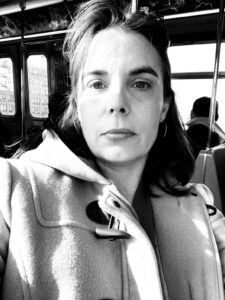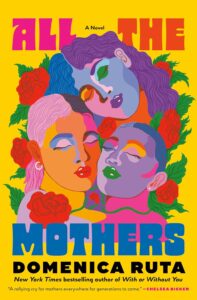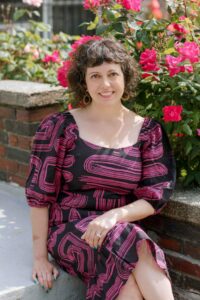
 An Interview with Domenica Ruta, Author of the Novel All the Mothers
An Interview with Domenica Ruta, Author of the Novel All the Mothers
by Nicole Haroutunian
About a chosen family of mothers who have children—initially unbeknownst to them—with the same man, All the Mothers by Domenica Ruta is by turns devastating, hilarious, and paradigm-shifting. Structurally ambitious and narratively propulsive, the novel follows women making bold, courageous choices, forging their own paths, and showing up for one another.
In this excerpt, Sandy struggles to feed her curious baby, Rosie, as she waits to meet “the other mother,” Steph, and her child Ash, for the first time.
According to the latest text, Steph is still about twenty minutes away. Sandy tries angling Rosie onto her other boob, hoping it will inspire her to concentrate. It would be ideal if Rosie was fed and happy by the time Steph and Ashley arrived. I’m pretty and my body bounced back without effort and I’m wearing anti-trend jeans on purpose, this other mother will see. My baby is a good baby because I am a good mother, not the kind of woman who gets herself into this huge mess of a life.
Rosie spits out her boob again and smiles at her mother. The ends of her blond hair are starting to curl. Her light-blue eyes focus on Sandy with a wordless intelligence. “You get it, don’t you?” Sandy says to her daughter. “We’re in this together, huh, Ro?” She is a good baby, whatever that means.
Then that good baby ejects a stream of puke directly into her mother’s face. Hot and chunky, it gets in Sandy’s hair, dripping down her neck, soaking through her shirt. Her white shirt. Such a rookie mistake. She rifles through her sleek black baby bag. There are two changes of clothes for Rosie but nothing for herself. Another failure.
Sandy wipes her face with her bare hand. She looks up. A woman and her child are standing in front of them. “Oh, hi,” Sandy says. “Are you—”
“Yeah,” Steph says. She smiles.
From the book ALL THE MOTHERS: A Novel by Domenica Ruta. Copyright © 2025 by Domenica Ruta. Published by Random House, an imprint and division of Penguin Random House LLC.
Domenica, you reached out after reading an interview about the reading series I program, “Story Time” for Parents and Caregivers, at the Astoria Bookshop. This series happens at 11:30am–traditional story hour—but is for the adult brains of the caregivers rather than for the little ones. I can’t wait to host you for our July installment! If you don’t mind me sharing, you wrote that, in the postpartum period you were “more cortisol than any other human substance.” You also thanked me for “creating the thing I needed back then, and honestly still need now.” Can you share what grabbed you about this idea?
The isolation and intellectual starvation of early parenthood is so hard for so many people. For single moms, like I was with my first kid, it can get very Yellow Wallpaper, very Sylvia Plath, very quickly. The loneliness is intense and painful, even when you are full of oxytocin and love for this new baby (or toddler—even harder!) Finding a low-stakes, high-enjoyment, understanding community during the matrescence phase is really hard. I remember the movie theater near me would have these special midday screenings for parents of babies where the sound was a little softer and you could bring your stroller, and no one would kick you out if your baby cried. I tried to go to one of those but 1.) it cost money, which was not abundant at that time in my life and 2.) it was often a movie I didn’t want to see. And you’re still alone in the dark with your baby. What you’ve created responds so beautifully to all the complex needs of caregivers. I’m blown away by both your creativity and follow-through, especially as you are balancing parenting and writing yourself.
All the Mothers opens with a scene of a new mom, Sandy, at work “wearing nothing but ankle boots and a raggedy pair of panties,” pumping milk on the toilet of “the same bathroom her boss uses” (1). I haven’t pumped in six and a half years yet your visceral descriptions brought back all of it: the sounds, the sensations, the abject disappointment of seeing just how little milk had collected in the bottle. I imagine you must have had personal experience with pumping to have written those all-too-real details—am I right? How close or distant were you from the pumping phase when you wrote that scene?
First, I need to say I am not a breastfeeding purist. I happened to have an easy time with it, but that is random biology, and I know so many mothers who struggle with it and are made to feel awful about something that is not in their control. I had to pump with my first kid because I shared custody of him (still do) with his dad, and for the first six months, that was his only food. The sound of the machine made me think I was going crazy! When I was writing the first draft of this book, I had gotten married to my current partner and was nursing our newborn, my second kid, during the peak of the pandemic lockdown. I pumped then out of fear that, if I caught the virus and was hospitalized, at least there would be a supply of frozen milk for the baby if I was gone. Luckily that never happened. But the sound of the pump still made me have low-key auditory hallucinations, which I gave to Sandy in the book.
After that incredible introduction, the book backs up through a series of Sandy’s ex-boyfriends, leaving the reader guessing as to which one is going to wind up being the baby’s father. I loved how it became like a series of fake-outs but was also struck by what felt like an unconventional way to start a book. How did you arrive at this structure? Was it always that way or did you come to it through revision?
This structure did not appeal to a lot of editors. I got a lot of passes on this book when it went out on submission, and a common thread of that criticism was, “is this a book about dating or a book about motherhood? Pick a lane.” (I’ve never been very good at picking a lane in any area of my life, least of all writing.) What I love about the structure is the Russian nesting dolls of different stories emerging. And smart read—yes, for tension’s sake, I wanted to tease out Sandy’s journey to becoming a single mom and also dramatize how compulsory heteropatriarchy is really not working for her, despite her best efforts to force it to work. All the Mothers is a story about shedding old identities that don’t suit you and letting new ones you didn’t know existed arise, so I wanted there to be a clear before and after for her character. And so, the parade of ex-boyfriends! It was actually longer and more elaborate, including more ex-boyfriends, but to keep the book moving I needed to cut it down a bit.
Thinking more about what wasn’t working for Sandy in the “before,” you depict the loneliness of being in a group of friends and suddenly seeing through what they pretend— or maybe even actually believe—is closeness, to the loneliness, the mismatch of priorities and desires and connection, underneath. Can you talk about how Sandy’s friend group functions in the book?
I’ve observed this dynamic so many times, in my own life and up close in the lives of people I know. Sandy’s friends are loyal to the institution of hetero-capitalist monogamy first and foremost. That is their reason for being. Even when they have ambitious career goals, they push them aside for the success of this larger enterprise. And Sandy buys into it completely, until she’s thrusted onto a different path, and she can’t pretend it’s working anymore, for herself or her friends.
The book is so honest about a certain kind of woman’s preoccupation with thinness and fitness, with “cheat day pastries” and carbs. It felt brave to me, this acknowledgment of how women can think about food and their bodies—even though we know it’s like this, I think a lot of times literary books don’t go there. Did it feel brave to write?
It’s a subtle thing I hope people notice that when Sandy meets Steph she starts eating more. Basically, when she is seen and held and loved fully by another person for the first time in her life, she doesn’t want to punish her body anymore. She wants to be alive, and to eat is to live! I wish I could say this tendency among women is a relic of the past, but it’s not. So reflecting that in Sandy’s “before” life felt important, as it is another symptom of the false self she is holding on to.
I did notice that—the astonishment and gratitude she has at being fed when she is with Steph. Part of it, too, seems like she’s suddenly not responsible for feeding herself on her own; there are others who want to serve her. There’s a Christmas feast, there are delivery onion rings.
When Sandy and Steph discover they both have kids with the same man and decide to meet, they have an instant chemistry and, before long, they move in together. It was such a relief to read them make that call–it’s a solution I can imagine other characters, and real people of course, dreaming of, but not making a reality. I remember a few years ago, there was a viral article in the New York Times about a “mommune” that really captured people’s imaginations. As soon as it went up, a mom in my neighborhood posted on our local parent Facebook group to see if anyone would form a mommune with her. I was sort of heartbroken for her that no one—not that I know of anyway—took her up on it. How did this idea originate for you?
I’m heartbroken for her too! I hope she found a more receptive community elsewhere. I got the idea for the two moms meeting and becoming allies, friends, chosen family from my own life. My son’s father had a baby with another woman when my son was about two, and I was very curious about her. Turns out, she was very curious about me, and when finally we found each other—over social media—we decided to meet, and it was platonic love at first sight. That premise is the seed of the story. Everything else is what happens when I let my imagination take the wheel.
There are aspects of your book that I think are quite clear from things like the title and the book cover and you sending me a brief synopsis that still came as a surprise to me because I was so in the flow of the story, so in it with Sandy, and then with Sandy and Steph, that I just wasn’t anticipating what was about to happen. And see–I am avoiding asking directly about the second half of the book because I don’t want to give away the surprise of it for other readers. You know, the surprise that is on the literal cover of your book. So rather than get too pointed about it, I’ll ask this: how did you think about the other mothers in the book? Not the central chosen-family mothers, but the antagonists who orbit them, and even Sandy’s mother?
I love this question and appreciate how protective you are of the twists! Thank you! There are two older mother figures who mirror Sandy in painful ways, forming a triptych of female archetypes. First we have Sandy’s mother, who is a woman of a certain generation—a very young boomer/old gen x—in which there was still nation-wide reproductive freedom but also a lot of social pressure to get married young, have kids young, and if you have time later, figure out a career and/or a pathway to actualization and self-fulfillment. So she gets married to a man (Sandy’s father) whom she does not love, not because of her unplanned pregnancy with Sandy, but because she was at an age where the stigma of being single was too much for her. Then we have Tara, Sandy’s quasi-mother-in-law and grandmother to her baby. Tara grew up in the same generation as Sandy’s mom and came to motherhood through a similar path—out of social and economic necessity. In her case, she is widowed and then devotes the rest of her life to babying her son all the way into his stunted adulthood. She does this out of love, yes, but also desperation, because she doesn’t know who she is if she’s not taking care of a man. There’s a scene at Sandy’s baby shower where Sandy realizes her supposed ride-or-die squad of friends are a shallow chorus at best, that they are loyal but not intimate or honest or real. And in the background, subtly, Tara’s friends prove to be the same, singing a brainless chorus about her dead husband the saint, when the true picture is anything but. The difference is Tara stayed with these same friends for the rest of her life whereas Sandy sheds this old self and finds something new for herself.
As a craft nerd, I’ve been so excited to ask you about point of view. The book begins in Sandy’s POV but then, as we meet the titular other mothers, it becomes almost a collective POV. The first time we got a thought from Steph’s perspective, I thought we were switching over to a section through her eyes. I was intrigued but sad to leave Sandy behind. It quickly became clear that something more complicated was going on than a POV switch-up. It was interesting to me because I’ve read books in the first-person plural, but this was, in some ways, a third-person plural? How did you approach this question of point of view?
This is so difficult to pull off, and I’m honored you clocked it, as I worked really hard on this and still don’t feel sure I quite nailed it. The industry standard, if you want to use more than one POV, is to write a largish chunk of the narrative in character’s voice, whether first person or a close third, then start a new section in the other character’s POV and stay there for a really long time. Or to organize each chapter in a sole character’s POV and alternate more frequently and even name the chapters after the character whose POV it is so that the reader doesn’t get confused. To do anything else will cause an uproar from editors and agents, which I find insulting to the readers, as if they aren’t smart enough to roll with something more fluid, more dynamic. I wanted this story, by the end, to feel like it belonged to everyone (despite starting with Sandy), and to create the joyful chaos of voices that a real family has. So I zoom in and out of POV’s and back to a more omniscient 3rd person, using paragraph breaks to keep the lines clean. I hope it works!
I am grateful you landed with a publishing team that let you structure the book in the way you did and employ this “joyfully chaotic” point of view. Thank you for this raucous, challenging, and defiant work of art.
Domenica Ruta is the NYTimes bestselling author of the memoir With or Without You, the novels Last Day and All the Mothers, and short stories in the Iowa Review, the Boston Review, and elsewhere. She co-edited the anthology We Got This: Solo Mom Stories of Grit, Heart and Humor. She lives in NYC with her family.
All the Mothers, by Domenica Ruta
Random House 2025
Hardcover 304 pages
ISBN 978-0593734056
 Nicole Haroutunian is the author of the novel-in-stories Choose This Now (Noemi Press, 2024), named one of the best short story collections of the year by Electric Literature, and the story collection Speed Dreaming (Little a, 2015). Her work has appeared in Story, The Georgia Review, The Rumpus, and elsewhere. She lives with her family in Woodside, Queens in New York City.
Nicole Haroutunian is the author of the novel-in-stories Choose This Now (Noemi Press, 2024), named one of the best short story collections of the year by Electric Literature, and the story collection Speed Dreaming (Little a, 2015). Her work has appeared in Story, The Georgia Review, The Rumpus, and elsewhere. She lives with her family in Woodside, Queens in New York City.
